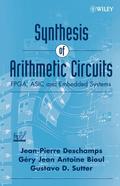
Synthesis of Arithmetic Circuits:
FPGAs, ASICs and Embedded Systems
 |
Synthesis of Arithmetic Circuits: FPGAs, ASICs and Embedded Systems |
|
|
|
VHDL Models
Chapter 1: Introduction
Chapter 10: Circuit synthesis: general principlesExample 10.1 (combinational circuit) Example 10.2 (sequential circuit) Example 10.4 (long operand) Example 10.6 (self-timed)
Chapter 11: Adders and subtractorsExample 11.2 (n-digit base-B carry-chain adder) Example 11.3 (n-digit base-B carry-skip adder) n-digit base-B carry-select adder)Example 11.7 (two-level n-digit base-B carry-lookahead adder) Example 11.9 (s**2-digit carry-lookahead adder) Example 11.10 (n-digit Brent-Kung base-B prefix adder) Example 11.11 (m-operand n-digit adder) Example 11.12 (m-operand n-digit sequential carry-save adder) Example 11.14 (an adder substractor) Example 11.16 (B's complement adder-subtractor) Example 11.17 (excess-E adder and subtractor) Example 11.17bis (excess-E adder and subtractor) Example 11.18 (sign-magnitude adder)
Chapter 12: Adders and MultipliersExample 12.1 (n-digit by m-digit base-B basic multiplier) Example 12.2 (n-bit by m-bit base-2 basic multiplier) n-digit by m-digit base-B basic sequential multiplier)Example 12.4 (n-bit by m-bit base-2 ripple-carry multiplier) Example 12.5 (n-bit by m-bit base-2 carry-save multiplier) Example 12.6 (n-bit by m-bit base-2 ripple carry multiplier using 4 by 2 digits multiplier cell) Example 12.7 (n-bit by m-bit sequential multiplier for signed operands) Example 12.12 (n-bit by m-bit booth-1 multiplier for signed operands) Example 12.13 (n-bit by m-bit booth-2 multiplier for signed operands) Example 12.14 (n-bit by m-bit booth-3 multiplier for signed operands)
Chapter 13: DividersExample 13.1 (n-bits base-2 restoring divider with p-bits quotient and n-bits remainder) Example 13.2 (n-bits by m-bits base-2 restoring divider with natural quotient of n-bits, and m-bits remainder) Example 13.3 (Base-B n-digits divider with p-digits quotient and n-digits remainder) Example 13.4 (n-bits base-2 non-restoring divider with p-bits quotient and n-bits remainder) Example 13.4bis (n-bits by m-bits base-2 non-restoring divider with quotient of n-bits, and m-bits remainder. There are 3 designs: X and Y naturals, X and Y integers, and integer X and natural Y in this last case the remainder R has one bit more (m+1 bits)). Example 13.6 (non-restoring Base-B n-digits divider with p-digits quotient and n-digits remainder) Example 13.7 (n-bits base-2 SRT divider with p-bits quotient and n-bits remainder, 2ís complement remainder) Example 13.8 (n-bits base-2 SRT divider with p-bits quotient and n-bits remainder. The remainder in carry save format) Example 13.9 (n-bits base-4 SRT divider with p-bits quotient and n-bits remainder. The remainder is in 2ís complement) Example 13.10 (n-bits base-2 Newton-Raphson inverter with p-bits quotient) Example 13.11 (n-bits base-2 goldschmidt divider with p-bits quotient).
Extra examples of Chapter 13 div_nr_f_pipe.zip A pipelined version of a n-bits base-2 non restoring divider with p-bits quotient and n-bits remainder. Normalized positive number are required. The constant Depth controls the logic depht.div_nr_sec.zip A sequential version of a base-2 non restoring divider. For naturals of X and Y-bits. The constant GRAIN defines the amount of bits computed at each cycle. The algorithm needs XBITS/GRAIN + 1 cycles to calculate the result.
Chapter 15: Circuits for finite field operationsExample 15.1 (binary (B = 2) modulo m adders and subtractors) Example 15.2 (binary (B = 2) modulo m shift-and-add multiplier) Example 15.3 (binary Montgomery multiplier) Example 15.4 (computes x modulo 2n - c, x being a 2.n-bit number) Example 15.5 (a mod 239 reduction circuit) Example 15.6 (computes y.x modulo m, where x and y are two n-bit numbers)
Chapter 16: Floating-point unitExample 16.7 (generic floating-point adder-subtractor. It is made up of four blocks) Example 16.8 (generic floating-point multiplier. It is made up of four blocks) Example 16.9 (generic floating-point divider. It is made up of three blocks)
|
This site was last updated 11/02/07